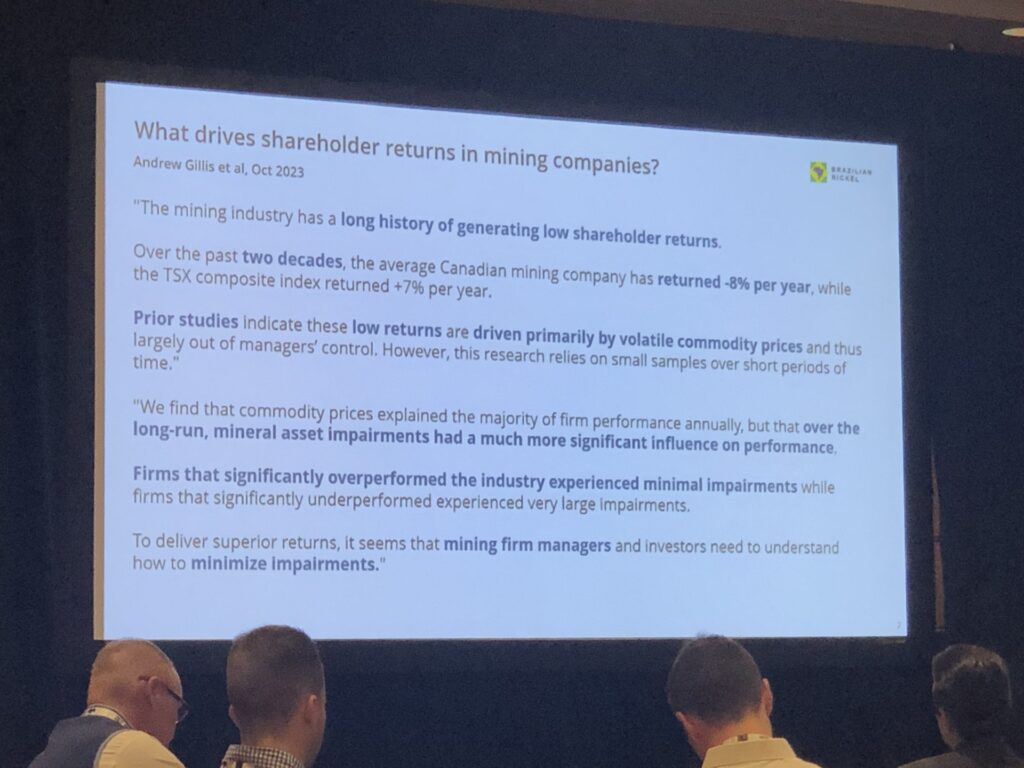Call Us Today: +1 866 205 2414
CIM Capital Projects Symposium 2024 Insights
By Kenny MacEwen
I recently attended this year’s CIM Capital Projects Symposium in Toronto—and one key takeaway was the invaluable lessons learned from past project failures. As industry leaders reflected on projects that veered off course, they emphasized a common theme: the critical importance of thorough planning and adherence to study gates.
The financial consequences of skipping these essential steps can be profound, affecting budgets, timelines, project scope, and stakeholder confidence. Proper upfront planning isn’t just a good practice for mining companies—it’s a safeguard against costly overruns and project derailment.
The High Cost of Inadequate Planning
While we all had some fun trying to decipher the four anonymous projects presented by Ken Murray, the presentation of this publicly available information highlighted the financial fallout from projects that underestimated the importance of planning. Without a solid plan, projects are far more likely to encounter delays, budget overruns, and unexpected hurdles that could have been mitigated with adequate preparation. These oversights often result in compounded issues, as the lack of clarity in one phase of the project affects every subsequent stage, creating a domino effect of setbacks.
In his keynote, “An Independent Analysis of the Recent Successes and Failures in Mining Projects,” Murray emphasized the importance of learning from past industry missteps. He pointed out that successful projects consistently rely on key pillars: a competent Owner’s Team, an effective organizational structure, a realistic feasibility study, a clear execution strategy, and skilled teams across permitting, engineering, contracting, and operational readiness. Even a minor oversight in planning can mean millions of dollars in added costs—a strain that few projects can afford.
Mining projects are especially vulnerable to these risks due to their large scale and significant capital requirements. As Ken noted, the key pillars to success for any project are a competent Owner’s Team, an effective organizational structure, a realistic feasibility study, an appropriate execution strategy, skilled permitting and engagement, competent engineers, experienced contractors, and thorough operational readiness.
The Importance of Study Gates: A Systematic Approach to Risk Reduction
A recurring point during the sessions was the role of study gates in project success by reducing risks in execution. Study gates—decision points that assess a project’s readiness to move to the next phase—serve as checkpoints to ensure that each stage of the project is appropriately vetted and on track. By rigorously evaluating the project at these intervals, companies can catch potential issues early, reducing the likelihood of expensive corrections later. Mark Travers noted in his Keynote “Value creation through projects” that each gate is not without its “Chronic Unease” even as the project is de-risked. This approach and this concept show a level of maturity that has been developing in recent years regarding executive understanding of project development as it pertains to their overall growth pipeline and development.


Conference presenters noted that skipping or rushing through these study gates often leads to poorly defined project scopes, which are difficult to adjust once execution begins. This lack of definition increases the risk of cost overruns and introduces the potential for rework, scheduling conflicts, and operational inefficiencies.
Upfront Investment: Saving Costs in the Long Run
One of the conference’s most powerful messages was that investing in upfront planning and study gates pays dividends over the project lifecycle. While the initial outlay required to gather data, evaluate risks, and align project scope may seem substantial, it pales compared to the costs of correcting missteps later. When teams commit to a thorough planning process, they set a strong foundation that supports every aspect of project execution, from budgeting to resource allocation.
Conference speakers emphasized that this upfront investment in project planning mitigates financial risk and builds team confidence and stakeholder trust. A well-defined project with clear objectives and a realistic timeline reassures investors, communities, and regulatory bodies, fostering an environment of support and reducing external pressures that often arise when projects go awry. Insights from Ken Murray’s “Lessons Learned” keynote underscored that rigorous planning and study gates help prevent costly setbacks, as demonstrated in Project No. 1, where winter construction challenges and scope gaps led to delays and budget overruns, and Project No. 2, where late equipment orders and underestimated COVID impacts exacerbated costs. Olga Kovalik further highlighted the industry’s long-standing challenges with capital deployment and project delivery, stressing the need to learn from past missteps to avoid unnecessary delays and costs.
Additionally, more mature project planning will allow owners to move away from riskier contracting models like Time & Material, not to exceed, and unit rate contracts to move into a position of better leverage to shift risk onto the execution contractor. This cannot be achieved without a fully defined Project Execution Plan when gating through FEL-3 and substantially complete engineering prior to leading construction tenders. Both of these take additional time in the project schedule but substantially safeguard the owner against cost escalation.
Real-World Examples: The Consequences of Overlooking Planning
Several examples shared during the sessions illustrated how inadequate planning and skipped study gates have led to significant financial and operational consequences. Ken Murray emphasized that these oversights create a “domino effect,” where early missteps compound into costly delays and budget overruns. In one case, a major mining project faced months of delays and millions in added expenses due to poor initial planning and the absence of clear study gate milestones. This example served as a cautionary tale, highlighting how the failure to assess project readiness can have a lasting impact.
The conference also featured success stories and presentations by mature mining companies embracing a prior-proper-planning approach to project development. Companies that invest in robust planning can manage unforeseen challenges without significant setbacks, demonstrating that resilience lies in a well-structured roadmap that adapts to changing conditions without compromising project goals. Mark Travers emphasized the importance of focusing on value creation at the pre-FID stage to strengthen industry outcomes, while Joao Zanon shared Ero Copper’s success with the Tucumã Project, highlighting the value of early local partnerships and capacity assessments. Additionally, Johnna Muinonen’s insights on the complexities of project financing for critical minerals underscored the need for careful, adaptive planning in “niche” markets where financing structures differ from traditional bulk commodities.
These presentations demonstrated that the key to resilience lies in having a well-structured roadmap that can adapt to changing conditions without compromising project goals.
The Broader Impact: Building a Culture of Accountability
One of the lasting lessons from the conference discussions was the importance of building a culture of accountability within project teams. When companies prioritize thorough planning and follow the study gate process, they foster a mindset that values precision, responsibility, and long-term thinking. This culture of accountability benefits individual projects and strengthens the organization’s overall approach to project management, reducing the likelihood of similar issues arising in the future.
Investing in Planning for Lasting Project Success
The CIM Capital Projects Symposium made it clear that skipping planning steps and study gates is a shortcut with a high price. For mining companies aiming for sustainable project outcomes, a strong Owner’s Team committed to thorough planning and adherence to study gates is essential for safeguarding both finances and reputations. This focus on building capable Owner’s Teams and prioritizing comprehensive planning marks a positive shift in the industry, promising more predictable, efficient, and successful projects in the future.
If you’re ready to discuss how improved planning strategies could benefit your projects, let’s connect. Together, we can explore ways to avoid common pitfalls and build a strong foundation for lasting success in your mining endeavors.
TMG specializes in executive and operational consulting for the mining and oil and gas sectors. It offers tailored oversight and strategic guidance across all project stages to ensure optimal outcomes from conception to execution.
TMG committed to diversity and inclusion, based on the undisputed fact, that a fully inclusive environment, fosters a unique perspectives that can solve challenging problems and creates value, within the company, for our clients, the communities of which we work, and the world at large.
TMG’s corporate vision and values, are to honour the rights and cultures of all people and respectfully approach all business, with fair dealings and establishing and maintain a mutually respectful relationship.
TMG acknowledges that our offices are located on traditional lands of divers First Nations and Indigenous peoples. Guided by the Constitution of both Canada & the USA, the United Nations Declaration on the Rights of Indigenous Peoples (UNDRIP) and the recommendations of all Truth and Reconciliation Commission as a framework, we are committed to taking ongoing positive and concrete steps towards reconciliation.
Copyright © 2024 Technical Management Group Ltd.